
ATI Analysis
Sample Size
Notation
ATI Flow Chart

Step 1: Test Proportion of Variance

n.s. -> Stop
sig. -> Go to Step 2
Step 2: Test Interaction

sig. -> Go to Step 7
n.s. -> Go to Step 3
Step 3: Test Common Regression Coefficient

sig. -> Go to Step 5
n.s. -> Go to Step 4
Step 4: Test for Treatment

sig. -> Significant Treatment Effect

n.s. -> No Significant Effects, Stop
Step 5: Test Intercepts

sig. -> Separate Intercepts

n.s. -> Go to Step 6
Step 6: Compute Single Regression Using the Continuous Variable

Stop
Step 7: Compute Separate Regression Equations. Establish Regions of Significance

Stop
Numerical Example
Step 1: Test Proportion of Variance

sig. -> Go to Step 2
Step 2: Test Interaction
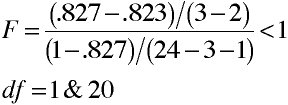
n.s. -> Go to Step 3
Step 3: Test Common Slope

sig. -> Go to Step 5
Step 5: Test Intercepts

sig. -> Calculate Separate Intercepts
Y' = 4.92 - 2.04X1 + .24X2
4.92 + (-2.04) = 2.88
4.92 - (-2.04) = 6.97
Y' = 2.88 + .24X2
Y' = 6.96 + .24X2
Stop
Categorizing Continuous Variables
Determining the Point of Intersection
p = (a1-a2)/(b2-b1) = (7-2)/(.8-.3) = 10
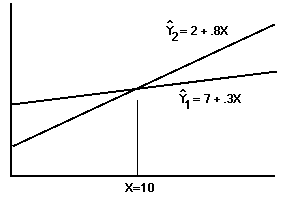
Johnson-Neyman Regions
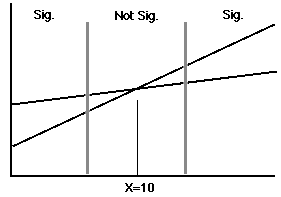
Stata Example
Step 1: Test overall model.
use http://www.philender.com/courses/data/ati2, clear
describe
regress score i.treat##c.ability
Source | SS df MS Number of obs = 200
-------------+------------------------------ F( 5, 194) = 26.43
Model | 7244.37532 5 1448.87506 Prob > F = 0.0000
Residual | 10634.4997 194 54.8170087 R-squared = 0.4052
-------------+------------------------------ Adj R-squared = 0.3899
Total | 17878.875 199 89.843593 Root MSE = 7.4039
------------------------------------------------------------------------------
score | Coef. Std. Err. t P>|t| [95% Conf. Interval]
-------------+----------------------------------------------------------------
treat |
2 | -4.066235 8.960134 -0.45 0.650 -21.73802 13.60555
3 | -9.605377 9.833632 -0.98 0.330 -28.99993 9.789176
|
ability | .4528834 .1499795 3.02 0.003 .1570837 .748683
|
treat#|
c.ability |
2 | .1048889 .1714919 0.61 0.542 -.2333391 .4431168
3 | .1435465 .2004388 0.72 0.475 -.2517725 .5388655
|
_cons | 28.6791 7.583058 3.78 0.000 13.72328 43.63492
------------------------------------------------------------------------------
twoway (scatter score ability, jitter(2))(lfit score ability if treat==1) ///
(lfit score ability if treat==2)(lfit score ability if treat==3), legend(off)
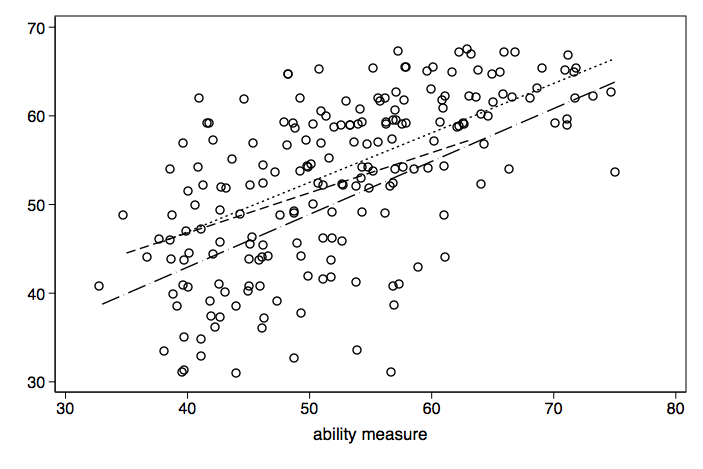
The F-ratio, F(5, 194) = 26.43, for the full model with treatment, ability, and interaction is significant, go to Step 2.
Step 2: Test interaction.
testparm treat#c.ability
( 1) 2.treat#c.ability = 0
( 2) 3.treat#c.ability = 0
F( 2, 194) = 0.27
Prob > F = 0.7604The interaction is not significant, go to Step 3.
Step 3: Test common regressio, coefficient.
regress score i.treat ability
Source | SS df MS Number of obs = 200
-------------+------------------------------ F( 3, 196) = 44.20
Model | 7214.30058 3 2404.76686 Prob > F = 0.0000
Residual | 10664.5744 196 54.411094 R-squared = 0.4035
-------------+------------------------------ Adj R-squared = 0.3944
Total | 17878.875 199 89.843593 Root MSE = 7.3764
------------------------------------------------------------------------------
score | Coef. Std. Err. t P>|t| [95% Conf. Interval]
-------------+----------------------------------------------------------------
treat |
2 | 1.248212 1.381794 0.90 0.367 -1.47688 3.973304
3 | -2.600438 1.532905 -1.70 0.091 -5.623543 .4226668
|
ability | .5476883 .0635714 8.62 0.000 .4223166 .6730601
_cons | 23.93675 3.364732 7.11 0.000 17.30102 30.57247
------------------------------------------------------------------------------
predict p2
sort treat p2
graph twoway scatter score p2 ability, s(oh i) c(. L) jitter(2) legend(off)
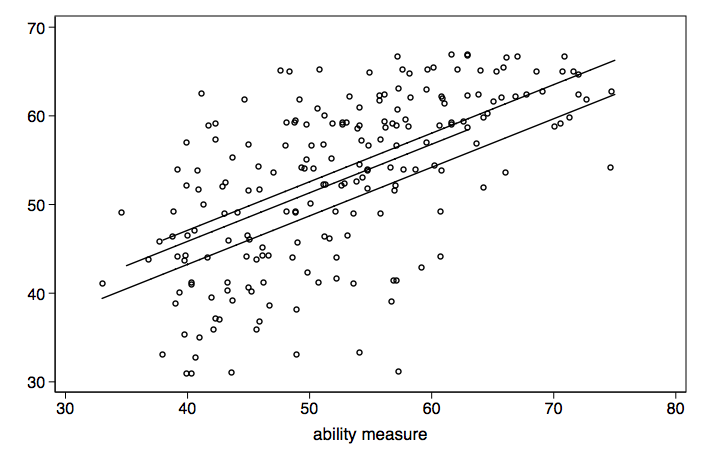 test ability
( 1) ability = 0.0
F( 1, 196) = 74.22
Prob > F = 0.0000
test ability
( 1) ability = 0.0
F( 1, 196) = 74.22
Prob > F = 0.0000The regression coefficient for ability is significant, go to Step 5.
Step 5: Test intercepts.
testparm i.treat
( 1) 2.treat = 0
( 2) 3.treat = 0
F( 2, 196) = 3.66
Prob > F = 0.0276The treatment is significant, calculate seperate intercepts with common regression coefficient.
y' = 23.94 + 1.25(2.treat) - 2.6(3.treat) + .55(ability)
y' = 23.94 + 1.25(0) - 2.6(0) + .55(ability)
y' = 23.94 + .55(ability) {treatment group 1}
y' = 23.94 + 1.25(2.treat) - 2.6(3.treat) + .55(ability)
y' = 23.94 + 1.25(1) - 2.6(0) + .55(ability)
y' = 25.19 + .55(ability) {treatment group 2}
y' = 23.94 + 1.25(2.treat) - 2.6(3.treat) + .55(ability)
y' = 23.94 + 1.25(0) - 2.6(1) + .55(ability)
y' = 21.34 + .55(ability) {treatment group 3}